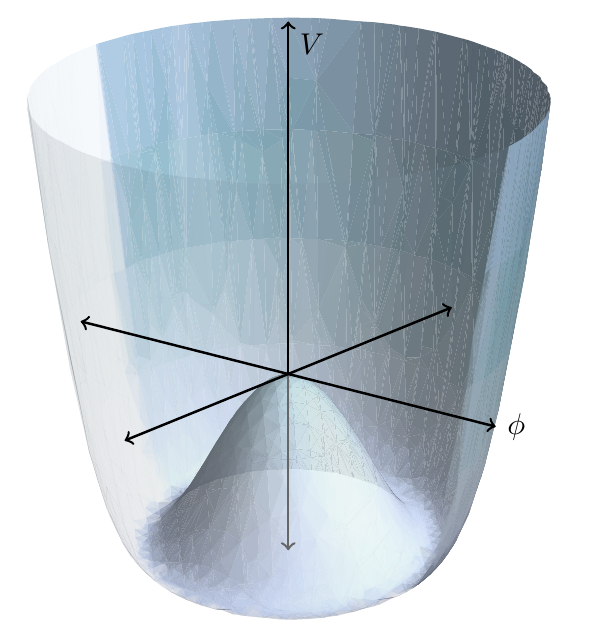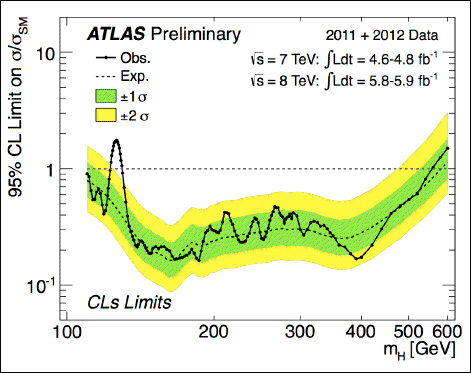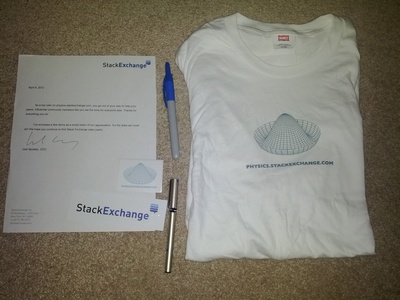The effect of peanut butter on the rotation of the Earth
Posted by David Zaslavsky onI do kind of wish more papers were this easy to understand.
So far as we can determine, peanut butter has no effect on the rotation of the earth.
I do kind of wish more papers were this easy to understand.
So far as we can determine, peanut butter has no effect on the rotation of the earth.

If you’ve been following the news about the discovery of the Higgs boson, you’ve probably noticed that it gets reported in two ways. There are the actual presentations with the full details of the experiments, which can only be understood by particle physicists their authors well, I’m assuming somebody knows what all of it means. Anyway, then there’s the other way. Sensationalized science journalism. “Hey, look, it’s a God Particle!!!11!” And Other Misrepresentations.
I think some of us want a middle ground, though. Certainly I would have, not too long ago. So if you’re not actually a physicist, but you’re also not afraid to look at a little math, this post is for you. (This is adapted from a post on Physics Stack Exchange.)
In order to understand the Higgs mechanism in detail, you need to know about two concepts that are involved in quantum field theory. The first is spontaneous symmetry breaking. This is actually a pretty simple idea: suppose that the physical laws that govern a system are symmetric in some way, meaning that you can make some kind of transformation on the system without changing the …

Well, there you go… the webcast from CERN is over, the results have been announced: CMS and ATLAS have discovered the Higgs boson respectively at \(\SI{125.3 +- 0.6}{GeV}\) with a statistical significance of \(4.9\sigma\), and at \(\SI{126.5}{GeV}\) with a statistical significance of \(5.0\sigma\)!
I totally called it :-)
Okay, to be fair, it didn’t take much (any) imagination to predict that result a mere 12 hours before it was announced. The rumors that were flying around over the past day turned out to be basically true. But the LHC detectors actually performed better than I would have thought — whereas I was expecting them to have to combine their results to constitute a discovery by the standard particle physicists use, the two experiments were actually both able to do it individually. (So what if CMS was \(0.1\sigma\) short — that’s close enough as far as I’m concerned.)
But what have they actually found? The standard model Higgs boson? Perhaps, but it’s too early to be sure. In order to verify what kind of particle this is, it’s going to take a lot more data collection and …
A couple of weeks ago, I posted about the rumors that were flying around the internet concerning the presumed discovery of the Higgs boson. At the time, those rumors were unfounded: nobody really knew what the results of the analysis were. But no longer! The LHC experiments will be presenting those results tomorrow, July 4, at 9 AM Zurich time — that’s 3 AM on the east coast of the US. There will be a live webcast of the presentation if you want to see the results as they happen.
So what exactly is going to be presented? Officially the results from ATLAS and CMS are being kept under wraps, but the rumors going around this time (which should be a little more reliable) suggest that the new data from both experiments support the bump at \(\SI{125}{GeV}\) that was last announced in December. It’s also been suggested that, while neither experiment individually has achieved the \(5\sigma\) significance physicists are waiting for to claim a “discovery,” when you combine the results from the two experiments together, they do exceed that \(5\sigma\) threshold.
Despite all the excitement, I think these rumors reflect exactly what most people in …
Finally, a post I can make in just a few minutes! The blogs of the physics world are abuzz with a rumor that the LHC experiments have… well, what have they (supposedly) found? If you read some of the more sensationalist physics websites out there, or the popular media (the news has even made it to the New York Times, although to their credit they’re being pretty reserved about it), you might get the idea that scientists at CMS and ATLAS have found the Higgs boson already and are just keeping the news officially under wraps until they can present it with much fanfare at a conference next month. That is not true.
It’s important to remember that finding the Higgs boson is not like finding a lost key or something: you can’t just look at it and say “yep, there’s a Higgs boson,” even if you do have what is essentially a giant microscope. Instead, it’s a probability thing. You analyze the results of the experiment and get out a result like “90% chance that the Higgs boson exists” or “95% chance that the Higgs boson does not exist” (actually even there I’m …

Back when I first signed up for arXiv, I posted an explanation of their moderately complicated (but not really) system of identifying authors. So now that I have another paper up, and this time I’m the one submitting it, I thought I might as well put together an explanation of how that process works. So if you’ve ever wondered what is involved in submitting to the arXiv, read on!
As the first step, if you don’t already have an account on arXiv, you have to create one. Once you do that, you start the submission process by going from your arXiv profile page, which looks like this:
Clicking START NEW SUBMISSION brings you to the beginning of the submission form.
arXiv will ask you to verify that your email address and affiliation are correct (if they’re not, you go back to the profile page and change them, then you can restart the submission). It’ll also ask if you’re submitting as an author (the usual case) or non-author. Then you have to select a license. Normally the default option is the one to go with, because if you are going to be submitting this paper …
OK, actually it is kind of a big deal. Discovering a new particle is not something that happens every day, and it’s a concrete result of having a well-tuned detector. Besides, it’s just cool. So congratulations to the CMS collaboration!
In case you haven’t heard the story, late last week CMS announced that they had a statistically significant observation of the \({\Xi^*}_b^0\) baryon, a particle made up of an up quark, a strange quark, and a bottom quark. In this case, “statistically significant” means that they detected this particular decay signature 21 times, of which only \(3\pm 1.4\) of them can be attributed to random coincidences in the detector. So they’re about as sure as you can be in physics that they are seeing signs of a real particle. They’ve also managed to reconstruct various properties of this particle by examining the decay products, and everything matches up with the predicted properties of the \({\Xi^*}_b^0\).
Now, why isn’t this a bigger deal, and why didn’t I write about it right away? Well, as I just mentioned, this particle was predicted to exist. Of course, the Higgs boson …
For years I’ve been hearing that Technorati is an essential way to promote your blog over the interwebs. Despite the fact that I still don’t entirely understand what this organization does or how it got so dominant in the making-your-blog-cool department, I figured I should probably cave… so this post is a step in the process of claiming my site in Technorati’s blog index.
If you’re wondering about this for your own blog, the process is (sort of) easy; just sign up, start a claim and fill out some information about your blog, and then you get a claim code like E3QA6PRUDVT9 (see what I did there) which has to be placed in a blog post so Technorati can verify it.
It remains to be seen whether this is actually going to amount to anything useful.
You may remember that about three months ago, the internet erupted in an uproar over two copyright protection bills, SOPA and PIPA, which were working their way through the House of Representatives and the Senate, respectively. Now there is another bill, the Cyber Intelligence Sharing and Protection Act (CISPA), which has many of the same people concerned. Indeed, a lot of privacy advocates are warning that CISPA is even worse than SOPA and PIPA. But other people are saying that it’s nowhere near as bad. One way or another, there seems to be a lot of misinformation floating around about this bill, so just as I did with PIPA, I thought it would be useful to go straight to the source and see what CISPA is really about.
As usual, this post comes with the standard disclaimer that I am not a lawyer and this is not legal advice. I make no guarantees about the correctness of this information. If you’re concerned about specific effects that CISPA could have on you personally, check with a lawyer.
Now then, to the source. The text of the bill itself can be found on the Library of Congress website as House …

This is coming kind of late, because I actually received it about a week ago, but the box of stuff I got for being a moderator on Physics Stack Exchange has finally arrived!
It includes a Physics Stack Exchange T-shirt and sticker, a generic Stack Exchange pen, Sharpie, and sticker, and a letter of appreciation from the company’s founder and CEO, Joel Spolsky.